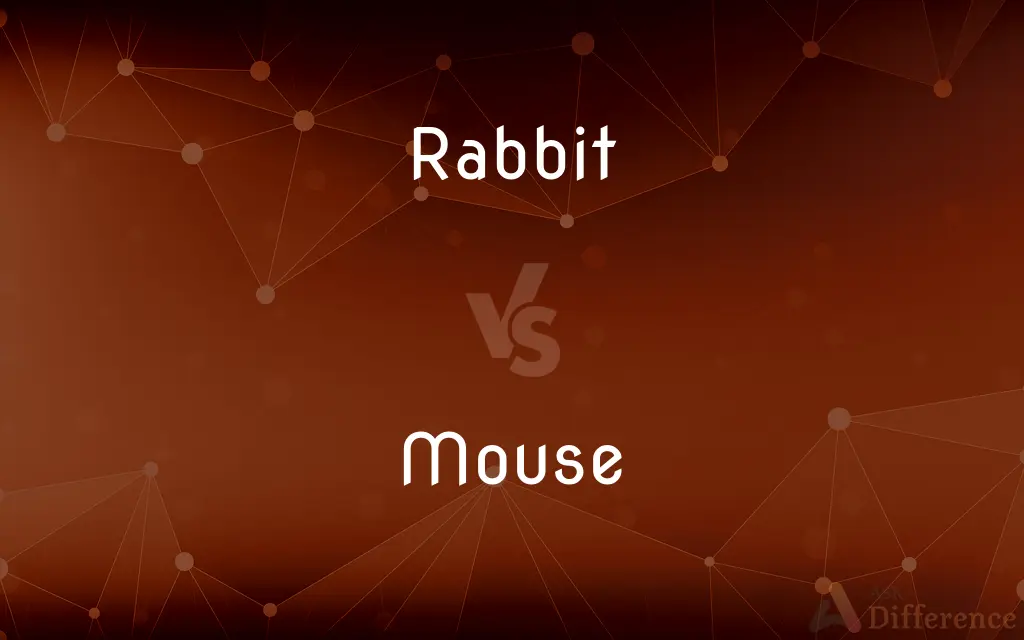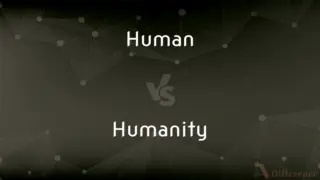Rabbit vs. Mouse — What's the Difference?
Edited by Tayyaba Rehman — By Maham Liaqat — Updated on March 26, 2024
Rabbits are larger, herbivorous mammals with long ears and strong hind legs, while mice are smaller, omnivorous rodents with a penchant for stealth and agility.

Difference Between Rabbit and Mouse
Table of Contents
ADVERTISEMENT
Key Differences
Rabbits are known for their distinctive long ears and strong hind legs, adapted for rapid movement and jumping. They are generally larger than mice, with a size that can vary significantly across different breeds. On the other hand, mice are smaller, with a more uniform size across the species. They possess shorter ears in proportion to their body size and are known for their agility and ability to squeeze into very small spaces.
Dietary habits also distinguish these two animals. Rabbits are strict herbivores, feeding primarily on grass, hay, and occasionally vegetables and fruits. Their diet requires them to have a unique digestive system, including a cecum for fermenting plant-based material to extract nutrients effectively. Conversely, mice are omnivorous, with a diet that can include grains, fruits, seeds, and sometimes insects or other small items. This flexibility in diet allows mice to thrive in a wide range of environments, including urban areas.
Social behaviors vary significantly between rabbits and mice. Rabbits can be very social animals, often living in groups and establishing complex social structures within their warrens. They communicate through a variety of means, including body language, scent marking, and soft vocalizations. Mice, while also social, tend to have more fluid group dynamics and can be territorial. They communicate through high-pitched sounds, many of which are beyond the range of human hearing, and scent marking.
Reproductive rates are another area of difference. Rabbits are known for their high reproductive rate, with the ability to produce multiple litters of offspring each year. This prolific breeding is a strategy to offset high predation rates in the wild. Mice also have a high reproductive rate, with the capacity to produce several litters per year, each containing multiple offspring. This trait is one reason for the mouse's success as a species in various environments.
The relationship with humans differs between the two species. Rabbits are often kept as pets or raised for their fur and meat. They are generally viewed positively in many cultures, associated with traits like luck and fertility. Mice, while also kept as pets in some contexts, are more often regarded as pests in urban and agricultural settings due to their tendency to invade homes and consume stored food.
ADVERTISEMENT
Comparison Chart
Size & Physical Traits
Larger, with long ears and strong hind legs.
Smaller, agile, with shorter ears relative to body.
Diet
Herbivorous, primarily eats grass, hay, and vegetables.
Omnivorous, eats grains, fruits, seeds, and insects.
Social Behavior
Social, lives in groups, complex social structures.
Social but can be territorial, fluid group dynamics.
Reproductive Rate
High, multiple litters per year.
Very high, several litters per year, many offspring.
Human Relationship
Often kept as pets, positive cultural associations.
Can be pets but often seen as pests, eating stored food.
Compare with Definitions
Rabbit
Serve multiple functions, including regulating body temperature and detecting predators.
The rabbit's ears twitched, picking up the faint sound of a predator.
Mouse
Capable of producing several litters a year, each with multiple offspring.
The mouse nest hidden in the attic was home to a growing family.
Rabbit
Adapted for leaping and running quickly to escape predators.
The rabbit leaped across the field with ease, using its powerful legs.
Mouse
Known for their ability to squeeze through very small spaces.
The mouse darted into a tiny crack in the wall, disappearing from sight.
Rabbit
Rabbits primarily eat grass and leafy weeds, contributing to their diet's high fiber content.
The rabbit munched on the clover in the garden.
Mouse
Often considered pests due to their habit of invading homes and consuming stored food.
The homeowner set traps to deal with the mice infesting the kitchen.
Rabbit
They live in groups and establish complex social structures within their burrows.
The warren was bustling with rabbits communicating and socializing.
Mouse
While social, mice can also exhibit territoriality, especially in crowded conditions.
The dominant mouse guarded its food stash from others.
Rabbit
Beyond pets, rabbits are also raised for their fur and meat.
The farm specializes in breeding rabbits for their high-quality fur.
Mouse
Mice have a varied diet, including seeds, grains, and occasionally insects.
The mouse nibbled on a piece of cheese left out on the table.
Rabbit
Any of various long-eared, short-tailed, burrowing mammals of the family Leporidae, such as the commonly domesticated species Oryctolagus cuniculus, native to Europe and widely introduced elsewhere, or the cottontail of the Americas.
Mouse
A mouse, plural mice, is a small rodent. Characteristically, mice are known to have a pointed snout, small rounded ears, a body-length scaly tail, and a high breeding rate.
Rabbit
A hare.
Mouse
A small rodent that typically has a pointed snout, relatively large ears and eyes, and a long tail.
Rabbit
The flesh of a rabbit, used as food.
Mouse
A small handheld device which is moved across a mat or flat surface to move the cursor on a computer screen
The right mouse button
Copy the file with a click of the mouse
Rabbit
The fur of a rabbit or hare.
Mouse
A lump or bruise on or near the eye
She touched the mouse under her eye
Rabbit
A competitor who is designated to set a fast pace for a teammate during a long-distance race.
Mouse
(of a cat or owl) hunt for or catch mice
Female cats are usually much better at mousing than males
Rabbit
A racehorse that is run at a fast pace early in a race in order to tire the favorite so that another horse can take the lead.
Mouse
Use a mouse to move or position a cursor on a computer screen
Simply mouse over any item on the list
Rabbit
A mechanical decoy that is propelled around the track in a greyhound race to incite the dogs.
Mouse
Any of numerous small rodents of the families Muridae and Cricetidae, such as the house mouse, characteristically having a pointed snout, small rounded ears, and a long naked or almost hairless tail.
Rabbit
To hunt rabbits or hares.
Mouse
Any of various similar or related animals, such as the jumping mouse, the vole, or the jerboa.
Rabbit
A mammal of the family Leporidae, with long ears, long hind legs and a short, fluffy tail.
The pioneers survived by eating the small game they could get: rabbits, squirrels and occasionally a raccoon.
Mouse
A cowardly or timid person.
Rabbit
(uncountable) The meat from this animal.
Mouse
(Informal) A discolored swelling under the eye caused by a blow; a black eye.
Rabbit
(uncountable) The fur of a rabbit typically used to imitate another animal's fur.
Mouse
Pl. mice or mous·es (mousĭz) Computers A handheld, button-activated input device that when rolled along a flat surface directs an indicator to move correspondingly about a computer screen, allowing the operator to move the indicator freely, as to select operations or manipulate text or graphics.
Rabbit
A runner in a distance race whose goal is mainly to set the pace, either to tire a specific rival so that a teammate can win or to help another break a record; a pacesetter.
Mouse
To hunt mice.
Rabbit
(cricket) A very poor batsman; selected as a bowler or wicket-keeper.
Mouse
To search furtively for something; prowl.
Rabbit
(comptheory) A large element at the beginning of a list of items to be bubble sorted, and thus tending to be quickly swapped into its correct position. Compare turtle.
Mouse
Any small rodent of the genus Mus.
Rabbit
Rarebit; Welsh rabbit or a similar dish: melted cheese served atop toast.
Mouse
(informal) A member of the many small rodent and marsupial species resembling such a rodent.
Rabbit
A pneumatically-controlled tool used to insert small samples of material inside the core of a nuclear reactor.
Mouse
A quiet or shy person.
Rabbit
(intransitive) To hunt rabbits.
Mouse
(computing) (plural mice or, rarely, mouses) An input device that is moved over a pad or other flat surface to produce a corresponding movement of a pointer on a graphical display.
Rabbit
To flee.
The informant seemed skittish, as if he was about to rabbit.
When the three friends heard someone behind them yell, "police, freeze!" they each rabbited in a different direction.
Mouse
(computing) The cursor.
Rabbit
To talk incessantly and in a childish manner; to babble annoyingly.
Rabbit on
Stop your infernal rabbiting! Use proper words or nobody will listen to you!
Mouse
(boxing) A facial hematoma or black eye.
Rabbit
Confound; damn; drat.
Mouse
(nautical) A turn or lashing of spun yarn or small stuff, or a metallic clasp or fastening, uniting the point and shank of a hook to prevent its unhooking or straightening out.
Rabbit
Any of the smaller species of the genus Lepus, especially the common European species (Lepus cuniculus), which is often kept as a pet, and has been introduced into many countries. It is remarkably prolific, and has become a pest in some parts of Australia and New Zealand.
Mouse
(obsolete) A familiar term of endearment.
Rabbit
Any of various burrowing animals of the family Leporidae having long ears and short tails; some domesticated and raised for pets or food
Mouse
A match used in firing guns or blasting.
Rabbit
The fur of a rabbit
Mouse
(set theory) A small model of (a fragment of) Zermelo-Fraenkel set theory with desirable properties (depending on the context).
Rabbit
Flesh of any of various rabbits or hares (wild or domesticated) eaten as food
Mouse
(historical) A small cushion for a woman's hair.
Rabbit
Hunt rabbits
Mouse
Part of a hind leg of beef, next to the round.
Mouse
(intransitive) To move cautiously or furtively, in the manner of a mouse (the rodent) (frequently used in the phrasal verb to mouse around).
Mouse
(intransitive) To hunt or catch mice (the rodents), usually of cats. 12
Mouse
To close the mouth of a hook by a careful binding of marline or wire.
Mouse
To navigate by means of a computer mouse.
Mouse
To tear, as a cat devours a mouse.
Mouse
Any one of numerous species of small rodents belonging to the genus Mus and various related genera of the family Muridæ. The common house mouse (Mus musculus) is found in nearly all countries. The American white-footed mouse, or deer mouse (Peromyscus leucopus, formerly Hesperomys leucopus) sometimes lives in houses. See Dormouse, Meadow mouse, under Meadow, and Harvest mouse, under Harvest.
Mouse
A knob made on a rope with spun yarn or parceling to prevent a running eye from slipping.
Mouse
A familiar term of endearment.
Mouse
A dark-colored swelling caused by a blow.
Mouse
A match used in firing guns or blasting.
Mouse
To watch for and catch mice.
Mouse
To watch for or pursue anything in a sly manner; to pry about, on the lookout for something.
Mouse
To tear, as a cat devours a mouse.
Mouse
Any of numerous small rodents typically resembling diminutive rats having pointed snouts and small ears on elongated bodies with slender usually hairless tails
Mouse
A hand-operated electronic device that controls the coordinates of a cursor on your computer screen as you move it around on a pad; on the bottom of the mouse is a ball that rolls on the surface of the pad;
A mouse takes much more room than a trackball
Mouse
To go stealthily or furtively;
..stead of sneaking around spying on the neighbor's house
Mouse
Manipulate the mouse of a computer
Common Curiosities
What do rabbits eat?
Rabbits eat a diet of mostly hay, grass, and leafy greens.
Are mice dangerous to humans?
Mice can spread diseases and contaminate food sources, posing health risks.
How fast can a rabbit run?
Some rabbits can reach speeds up to 35 mph in short bursts.
How long do mice live?
Mice typically live around 1 to 2 years in the wild, but can live longer in captivity.
Do rabbits need a lot of space?
Yes, rabbits require ample space to move, hop, and exercise.
What are baby rabbits called?
Baby rabbits are commonly referred to as kits or kittens.
Can rabbits and mice live together?
Generally, it's not advisable due to different care requirements and the potential for stress or harm.
Are rabbits good pets for children?
Rabbits can be good pets but require careful handling and proper care.
What diseases can mice carry?
Mice can carry diseases such as hantavirus, salmonellosis, and listeria.
Can mice be trained?
Mice are intelligent and can be trained to perform simple tasks or tricks.
How do mice communicate?
Mice communicate through scent markings and ultrasonic vocalizations.
How do mice find their way into homes?
Mice can enter through small openings or cracks in search of food and shelter.
Can rabbits live outdoors?
While rabbits can live outdoors, they need a safe, predator-proof enclosure.
What natural predators do rabbits have?
Common predators include foxes, hawks, and cats.
Do rabbits have a good memory?
Rabbits have a good memory for recognizing individuals and can learn to navigate complex environments.
Share Your Discovery

Previous Comparison
Astonished vs. Shocked
Next Comparison
Human vs. HumanityAuthor Spotlight
Written by
Maham LiaqatEdited by
Tayyaba RehmanTayyaba Rehman is a distinguished writer, currently serving as a primary contributor to askdifference.com. As a researcher in semantics and etymology, Tayyaba's passion for the complexity of languages and their distinctions has found a perfect home on the platform. Tayyaba delves into the intricacies of language, distinguishing between commonly confused words and phrases, thereby providing clarity for readers worldwide.
















































